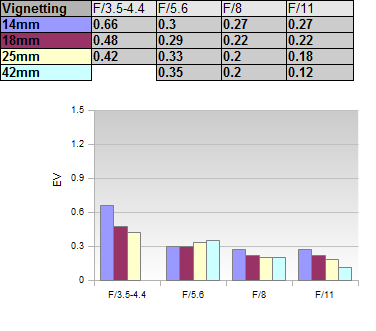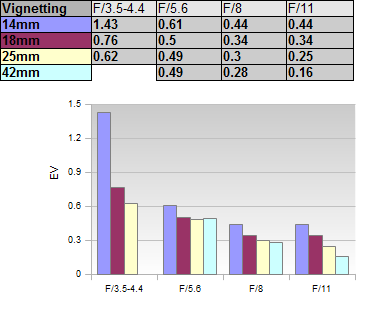|
Olympus M.ZUIKO 14-42mm f/3.5-5.6 II R - Review / Test Report - Analysis |
|
Lens Reviews -
(Micro-)Four-Thirds
|
|
Page 2 of 3

Distortion
By default, distortion is auto-corrected either in the camera (JPEGs) or in most RAW converters (Adobe products, Olympus, Silkypix), so user will typically never see the native characteristic of the lens. In the real life, the lens only shows moderate (1.8%) barrel distortion at 14mm and marginal barrel distortion beyond.
That said it is still possible to have a look behind the scenes e.g. by using CaptureOne (RAW-converter). In this case things aren't quite as good with a massive barrel distortion of ~6% at 14mm. However, even so there are no issues anymore between 18-42mm.
Vignetting
The auto-correction also applies to vignetting although this is mostly a side effect of the distortion compensation. Consequently the light falloff is quite moderate even at max. aperture peaking at just 0.6EV at 14mm f/3.5. This isn't overly disturbing and not an issue anymore at other settings.
 In uncorrected mode (albeit not fully comparable), the light fall-off more disturbing at 14mm f/3.5 (~1.4 f-stops) but even so the issue is mostly well-controlled from f/5.6 onward.
In uncorrected mode (albeit not fully comparable), the light fall-off more disturbing at 14mm f/3.5 (~1.4 f-stops) but even so the issue is mostly well-controlled from f/5.6 onward.

MTF (resolution)
The resolution figures of the Olympus lens are decent albeit fairly unexciting. The center quality is generally very good in the image center at the relevant aperture settings. The outer image region is good to very good at 14mm. The corners soften slightly at 18mm and 25mm but manage to remain on a good level. At 42mm there's a general drop in quality albeit not dramatically so.
The centering quality of the tested sample could have been better towards the long end of the range.
Please note that the MTF results are not directly comparable across the different systems!
Below is a simplified summary of the formal findings. The chart shows line widths per picture height (LW/PH) which can be taken as a measure for sharpness.
If you want to know more about the MTF50 figures you may check out the corresponding Imatest Explanations
Chromatic Aberrations (CAs)
The CAs (color shadows at the hard contrast transitions) are on the high side peaking above 2px on the average at the image borders at wide end and using a fully open aperture. The CAs decrease the more you stop down and they are reasonably well controlled from f/8 onward as well as at 42mm.

|